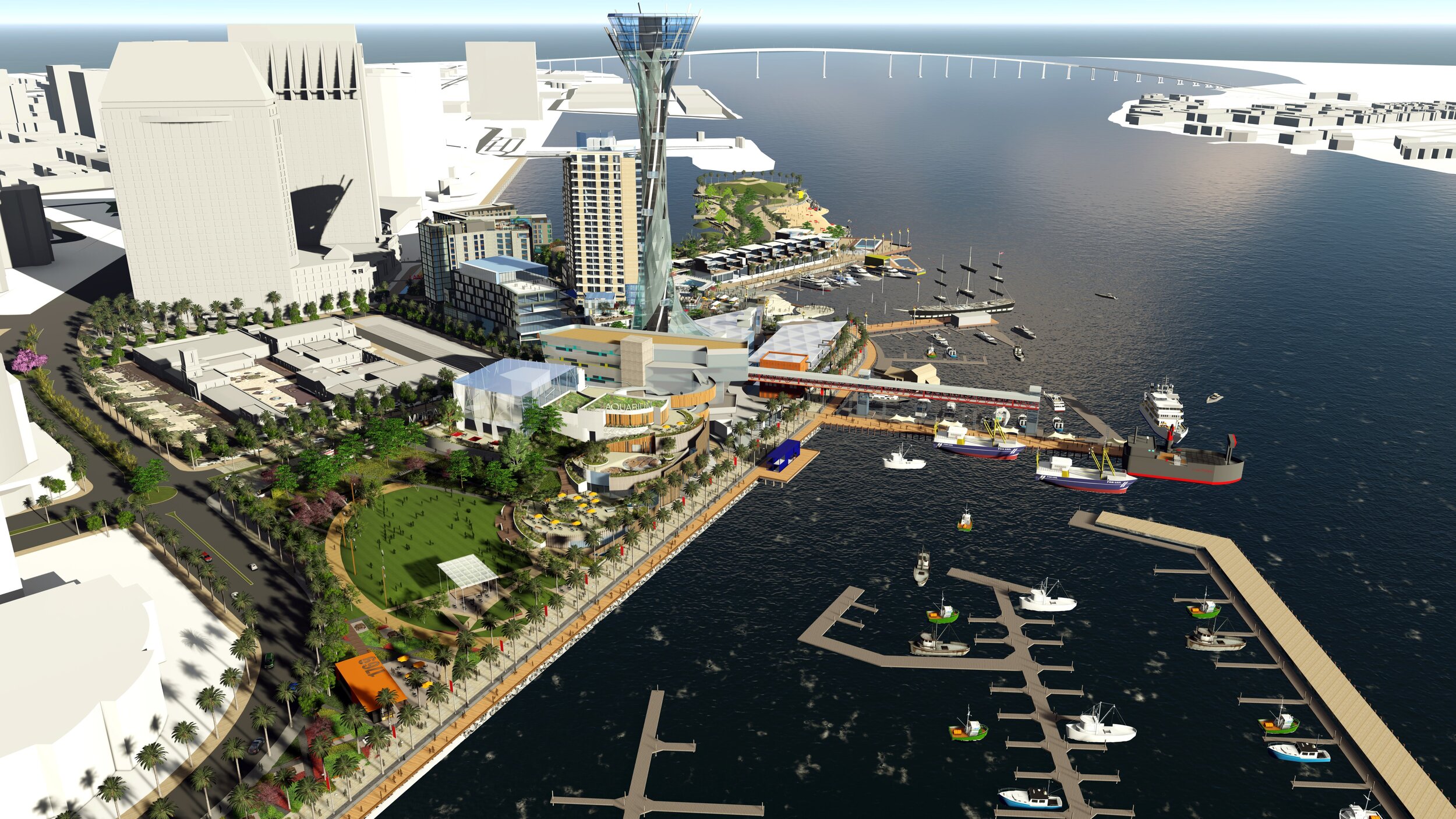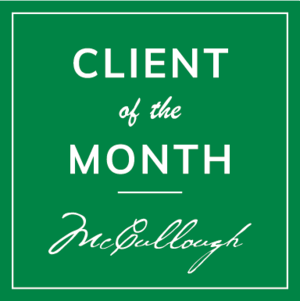Reclaiming Green Space Over San Diego’s Interstate 5
Imagine… Downtown San Diego bursting with an abundance of park space, walkable bridges over Interstate 5 healing divisions between fractured communities, and lush new green spaces that embody climate-positive benefits for a more sustainable future.
Could this be a possibility for San Diego?
Not only is it possible, but it is an important component of the Downtown Community Plan established in 1989. San Diego Commons (SD Commons) is a nonprofit organization focused on efforts to heal the divide created by Interstate 5 (I-5), aiming to gain park space that was part of the Downtown Community Plan. By covering the freeway trench with parkland “caps,” the new spaces will provide “common ground” that reconnects underserved communities.
Johanna Mall, McCullough Associate Landscape Designer and member of the San Diego Commons Board of Directors, has been spreading the word about San Diego Commons’ initiative to reconnect communities. This month, firm Marketing + Creative Manager Nikki Holloway met with Johanna after her presentation to the San Diego Green Building Council in June to learn more and find out how we can support the cause.
An Interview with San Diego Commons Board Member Johanna Mall
Let’s jump right in! Most San Diegans are all too familiar with the roaring Interstate 5 that cuts through downtown. Although it’s an important means for getting around, the reality of its presence is disruptive. How has it affected the original vision for the City?
Before construction of the I-5 freeway began in the 1950s, San Diego had an intimate connection with Balboa Park and its surrounding neighborhoods. Unfortunately, the building of I-5 severed the connection between downtown and communities such as Barrio Logan, Sherman Heights, and Golden Hill. This is significant because constructing the freeway meant cutting these neighborhoods off from economic and social opportunities.
It comes as no surprise that this transition has stirred many people, leading to a push to do something about it, which is part of how I got involved with SD Commons.
SD Commons is a nonprofit started in 2019 by San Diego civic leaders and professionals in the effort to install an important component of the Downtown Community Plan that would give 40 acres of park space back to our communities. The organization builds upon several years of work by like-minded community activists. The goal is to repair significant damage done to San Diego communities by developing cultural and natural resources accessible to all members of our society. This forms a “Commons” in the form of developed parks as covers over portions of the I-5 freeway downtown. Reconnecting Communities is a current working title of the mission of San Diego Commons.
You mentioned that, like many San Diegans, you were stirred to do something and ended up getting involved with SD Commons. What’s the background of this group, and how have you personally gotten involved?
A few years ago, the topic of the freeway covers originally came up at a Lambda Alpha International meeting. Freeways caps had been talked about for years and they were starting to show success in other cities around the country, such as Klyde Warren Park in Dallas, Texas. After the presentation, a group got together and formed “Heal the Gash” to ensure that this component was implemented. This vision is stated and proposed in the Downtown Community Plan.
I got involved with SD Commons over a year ago when our Principal, David McCullough told our staff about a collective meeting to discuss the implementation of freeway covers in San Diego. My ears perked up and before I knew it, I was participating at the in-person meeting. A group got together and formed a plan to ensure that this component was implemented. Other SD Commons board members are a collective of community activists, local architects and landscape architects, urban designers, residents, engineers, environmentalists, lawyers, and community program coordinators.
SD Commons is a way for me to get directly involved in my community and instill the values I believe in – for the welfare of the environment and the affected communities. I have very strong opinions and perspectives when it comes to our approach to the built environment and how it directly affects local culture and quality of life. I have always been intrigued by policies and how they shape our cities, so SD Commons was an opportunity for me to learn the grassroots process and have a say in the process itself.
Wow! SD Commons is a means for you to participate in real change that will shape the future of our City. What are your responsibilities as a member of the Board?
I serve as a general board member as well as a part of the Public Relations and Marketing Committee. As board members, we collaborate, providing feedback on documents and issues. I help wherever I can and have worked heavily on our presentation to community leaders, including iterations of the PowerPoint presentation. Each member individually reaches out to public officials, district representatives, and community leaders to spread the word of the Community Plan vision. The goal is to gain moral support from the communities that will be directly affected and benefit from this mission so that we can gain traction and ultimately implement the covers.
To be as involved as you are, you must be intimately familiar with the details of the SD Commons mission. Would you share a little about the plans being developed and what areas would be affected? How much park space would result from these plans?
There are two freeway covers over I-5 identified in San Diego’s general plan that are meant to provide new open spaces to downtown and the surrounding neighborhoods.
The first is Sherman Heights to East Village, from Island Avenue to K Street. A freeway cover here would bring open parkland to the neighborhood. It would also relieve some of the blight by covering the noise and pollution and bringing economic opportunity by reconnecting that community with downtown San Diego. Although the Balboa Park expansion is stated as the priority in the Downtown Community Plan, we believe it is more important that the underserved and underrepresented community of Sherman Heights be given the first opportunity of reconnection.
The second cover would be from Balboa Park to Cortez Hill in downtown, blocks from 2nd Avenue to 6th Avenue. This would expand Balboa Park so that it is more accessible from downtown, connecting Cortez Hill with Balboa Park and Bankers Hill. Development land could also be available in the Balboa Park Lid.
Those two covers would give San Diego about 20 new acres of public open space – 4.5 acres from the Sherman Heights/East Village lid and 14 acres from the Balboa Park/Cortez Hill/Bankers Hill lid.

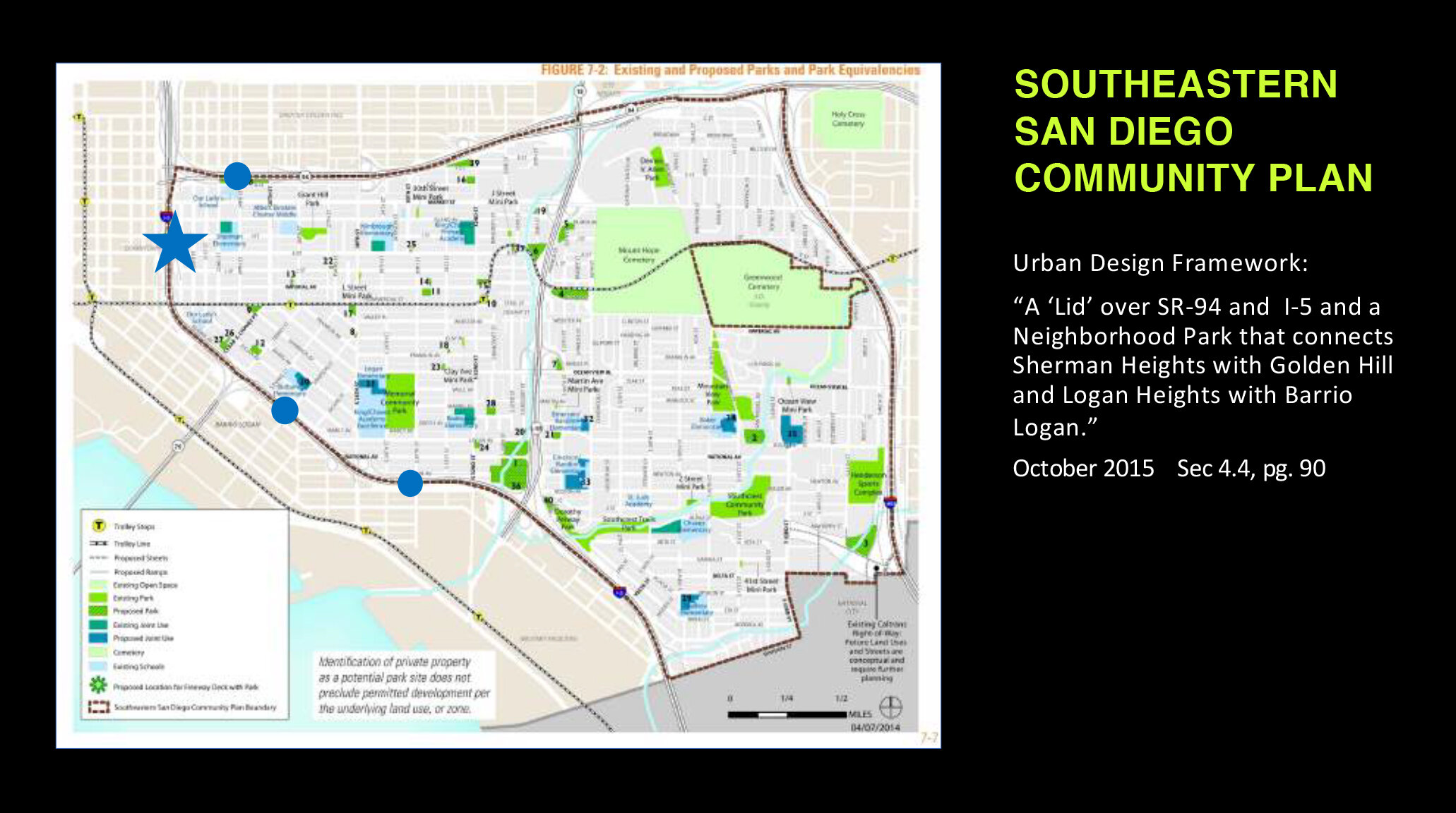
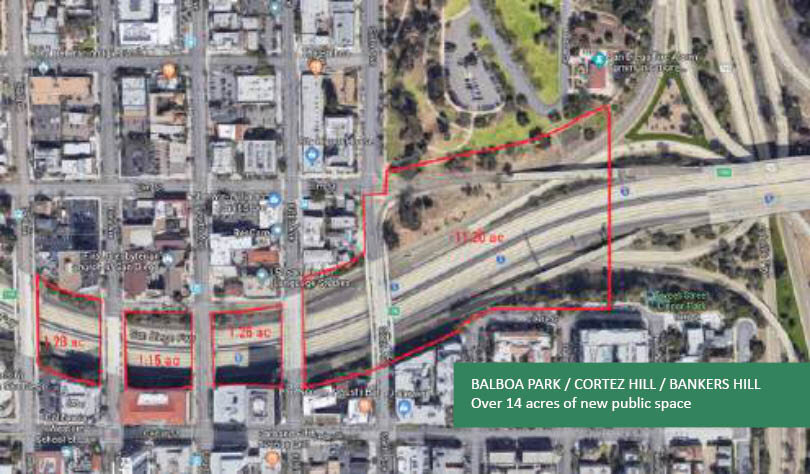
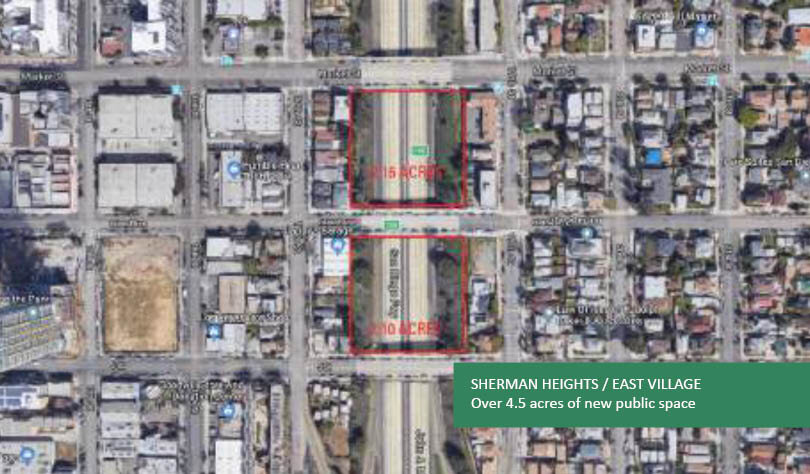
Opening so much additional space downtown seems like it would present many exciting opportunities! What are the benefits of covering the freeway with green, usable land?
While the immediate environmental benefits of having open parkland over the freeway are obvious, the most important factor of this initiative is to reconnect the communities that have been severed from downtown and the economic stress they have experienced because of the direct physical location of I-5.
This should also be seen as an opportunity for climate mitigation through carbon sequestration, the elimination of refractive heat (a.k.a. the urban heat island effect), noise reduction, and habitat restoration. The green spaces would help filter vehicle emissions and replace toxic, unusable airspace.
Although there are so many important benefits to this, have you had any opposition to these plans? What are the arguments against it?
While it’s hard to imagine why someone would be against covering the freeway with parkland, there are a few arguments against freeway caps. First, there is the question of funding and feasibility – how is it going to be funded? Teralta Park over the I-15 was supposed to be one out of seven caps. However, after several years working to make progress with Caltrans, this was the only park cover that made it into construction.
The next concern is the matter of gentrification. This is a hot topic with some pointing at the overly successful Highline in New York City, but I see it as a catch-22. We can’t ignore our under-served communities out of fear of serving them better.
Is the solution to gentrification to continue ignoring underserved communities out of the fear of rising real estate value displacing residents?
I personally do not think it is. While people point to Highline, I think it’s safe to say Teralta Park has not displaced residents in City Heights. The main difference is now there is a neighborhood park where children play basketball, shaded tables for sitting, paths and grass to walk and play – simple, but necessary amenities making a positive impact on the health and welfare of neighborhoods. There’s a difference between design attracting outside visitors versus design meeting the needs of a community. The proposed freeway parks are a blank canvas. They have yet to be designed. The intent is to involve the surrounding communities so they can take part in the process and have a say in their environment.
Have parkland freeway covers been successful in other cities? Perhaps there are inspiring ideas and lessons-learned to be found in those successes.
The Highline in New York City is a good example of how too much success can dramatically bring more change than the community can handle, leading to issues of gentrification. A burst of real estate development followed the implementation of the Highline, which skyrocketed real estate values and caused a loss of affordable housing.
While the Highline is a beautiful landmark and the “poster child” of the environmental and architectural ideals that we strive for, a main criticism of the Highline is that it has failed to serve the surrounding neighborhood it was originally meant for. To avoid that pitfall, SD Commons would hold community workshops and design charrettes in close coordination with community leaders to ensure that we truly meet the needs of the community while dancing the fine line of attracting visitors.
Hollywood’s Central Park has completed their feasibility studies and are in the CEQA documentation phase. They are years ahead of us in the process and have been very valuable, helping us with advice regarding the bureaucratic process.
What other obstacles need to be overcome to make this a reality?
The first thing that needs to be done is an Environmental Impact Report (EIR), and it’s not going to be cheap. We also need a feasibility study to determine the opportunities, constraints, and costs of the project. A big challenge we’ve faced is obtaining the funding for these expensive reports. This is why it is crucial for us to get support from the communities. We’re doing so by working to make them aware of the vision behind the Downtown Community Plan, in order to help them share our desire to make it happen.
One promising opportunity for our mission is the U.S. Federal Bipartisan Infrastructure deal, which includes $550 billion in federal investment in America’s infrastructure. One section of the deal focuses on “Reconnecting Communities” that past transportation investments have divided. In July, SD Commons President Roger Lewis went on a mission to Washington D.C. to speak to and gain support from senators and representatives of San Diego. We have high hopes to gain funding from this deal.
It sounds like SD Commons needs two things to get this moving: funding and volunteers. What can people do to get involved?
That is exactly it! This project cannot be done without community support. These park covers are meant for the communities. In partnership with SD Commons, the Sherman Heights Community Center is hosting the very first community design charrette in the beginning of Fall (late September/early October) to discuss the Phase One freeway cap in the Sherman Heights neighborhood. The knowledge base from the citizens themselves is crucial in this process. Please come out, bring your thoughts and opinions, and be part of the discussion! Keep an eye out at SDCommons.org for the announcement of the date and help spread the word.
We are always looking for new people to join our board to help with community outreach.
Besides that? Donate. Donate. Donate. We need all the financial help we can to fund the EIR and feasibility studies. SD Commons has an optimistic goal to enter the CEQA phase by 2025 and begin construction in 2028-2029. We have a lot to do to reach that goal.
Get involved with SD Commons by contacting us at info@sdcommons.org! We’d love to have the help!
If this became reality, how would it personally affect you?
Since San Diego is severed by several freeways, air quality and blight caused by the harsh vehicular environment is a real and major concern for me. The City is also severely lacking in open green space in downtown itself. When I first began working in San Diego, I would walk around outside to find a nice spot to eat my lunch – that’s when I quickly realized there is no common open space to go to in downtown San Diego. I am fortunate enough to live a few blocks away from Balboa Park, whereas residents in the neighborhoods of East Village and Sherman Heights must hop into a car or travel to find green open space and escape the built environment.
It’s clear to me that public space and public realm play a huge role in social justice. Investment in these green spaces means providing social and economic stimulation in underinvested, low-income communities. Urban building development without serious and sensitive consideration of neighborhood contexts leads to the lack of sense of place. My goal is to make meaningful places in San Diego while working to bring its communities the amenities they deserve. It is crucial to restore the feeling of identity in those communities that have been segregated by transportation infrastructure by returning open space back to them.
Thank you for sharing this important mission! Do you have anything else you’d like to add?
Citizens Coordinate for Century 3 (C3) did a great interview of SD Commons activists Mike Stepner and Vicki Estrada in this podcast episode – they share so much great information.
Want to get involved with San Diego Commons? Here’s how:
Contact info@sdcommons.org to learn about volunteer opportunities.
Make a donation to SD Commons in support of reconnecting San Diego’s communities.
Don’t forget to check SDCommons.org for details about design charrettes for each of the affected communities, including the Sherman Heights Design Charette coming this Fall!
Johanna Mall, ASLA
Associate
Nikki Holloway
Marketing + Creative Manager
Client of the Month:
Gafcon
Seaport San Diego
Our August Client of the Month has contributed to more than $50 billion in bond projects, has won over 150 awards for projects delivered in the past 10 years, and has worked with us on iconic local and international projects including Seaport San Diego…
We are thrilled to feature Gafcon as our Client of the Month!
For over 33 years, Gafcon has been a leader in providing owner representative services to private and public clients. Gafcon’s expertise is made evident by their talented team of people, cutting-edge technology, and unique processes. They are easily set apart from their competition and currently ranked #44 among Engineering News Record’s (ENR) Top 50 Program Management Firms for 2021!
Based in San Diego, with offices in Los Angeles and Orange County, Gafcon’s portfolio showcases a diverse mix of local and international projects in education, entertainment, mixed-use, municipal, waterfront, and healthcare. Their services include program/project management, construction management, digital technology, labor relations, claims solutions, multifamily renovations, and development.
Genuine. Adaptive. Dedicated. Articulate. Decisive.
Much like McCullough, Gafcon considers its people and their collective values and goals to be the foundation of their success. They define success by projects that create impact and benefit the needs of the communities they serve. The “Gafcon Tribal Code” of company values includes:
Delivering complex projects that power vibrant communities
Continually seeking new knowledge and delivering with the highest quality
Looking beyond the obvious to find solutions to complex problems
Becoming their clients’ partner and anticipating their needs
Work hard, play hard
Creating value for their clients, communities, and for each other
McCullough is honored to have had the opportunity to partner with Gafcon for some of our most valued, prestigious projects over the past several years. We continue to team with Gafcon for current and upcoming pursuits. Two of our favorite, most notable projects are Seaport San Diego and Zizhu Purple Bay.
ZIZHU PURPLE BAY, SHANGHAI, CHINA
In 2016, Gafcon gave McCullough the unique opportunity to join the team of visionaries leading the master planning and development for a 3,200-acre, waterfront urban center in Shanghai, China. As the landscape architect, our collaborative project partners include AVRP Studios, Gensler, City Design Studio, Moffat & Nichol, OdySea, Perkins Eastman, Fentress, and many others. Yehudi “Gaf” Gaffen, Gafcon’s CEO, said it best when he shared, “This is a legacy project at a tremendous scale. We are essentially building a new city from the ground up.”
Phase one of the Zizhu Purple Bay Development is an 800-acre mixed-use community surrounding a lake, known as Purple Lake, with yacht homes, condos, a nature and education center, an aquarium, and a botanical garden. The meticulous design embraces the natural waterfront along the Huangpu River at the edge of the property and features a man-made canal that passes through the site, a retail center, a waterfront park, and a nature walk leading to the water's edge.
The second phase involved enhancing amenities and features and will provide a business, tech, and education district; housing for the business workforce; hotels; a health center; senior housing; an equestrian center; a library tower; a winter sports facility; a mobility system; a nature-interpretive park; an aquarium; an arboretum; and artist community with sculpture gardens, exhibition spaces, workshops, and more.
For the third phase, Gafcon retained McCullough to study gardens that will surround a new luxury hotel for Zizhu. The hotel is the Orchid Lake Luxury Resort Hotel, which will reside on the east end of Purple Lake. Named Purple Garden, the gardens, spanning nearly 100 acres, will consist of a series of spaces that will encapsulate the hotel at Purple Lake’s edge. Read more about Purple Garden.
The images of Seaport San Diego above reflect early project work and may differ from the current design.
SEAPORT SAN DIEGO
Spanning 70 acres of land and water that make up San Diego’s Central Embarcadero, Seaport San Diego is a highly anticipated mixed-use redevelopment that will “offer visitors world-class recreational, commercial, cultural and educational attractions, while incorporating the rich aquatic heritage and industry of the region.” Yehudi “Gaf” Gaffen is the active managing partner guiding the project to successfully bring the new vision to reality.
McCullough has been involved in the first phases of the conceptual design for the development leading up to the project entitlements for the port. We look forward to helping bring the vision to life in later portions of this pivotal, multi-phased project for the City.
Our additional collaborative project experience with Gafcon includes:
Mission Ridge Apartments Renovation
Master Planning for a Confidential Tribal Client
Harborside Park on Oxford
Grossmont Cuyamaca Community College Instructional Building F1
Grossmont Cuyamaca Community College Instructional Building F2
Other eco, community, tribal, and transit-oriented development projects
We are excited to share more about these monumental projects as our work progresses. To learn more about Gafcon, visit their website at www.gafcon.com.
Nikki Holloway
Marketing + Creative Manager
From San Diego to the Bay Area: Industry Trends in California
This past month, Principal David McCullough participated as a BISNOW panel member for three important discussions for the State of California.
BAY AREA ARCHITECTURE & DESIGN
Kicking things off in San Francisco July 29th, David was part of the panel for “The Future of Architecture & Design in the Bay Area.” With great insights from all panel members, David shared why he’s excited for the current shift in focus toward the public realm:
“We like to encourage this idea of the City as an amenity. It’s not just about your building, it’s not just about your project. It’s the things around it and how they interact with each other… The thing that’s really exciting is the agencies are realizing that the cost of purchasing property for parks and things like that is very expensive. So, the new model, which I’m just so happy–could not be more excited about, is to take the public realm that they already have, the streets, the sidewalks, and utilize them in a more productive way.”
– David McCullough, ASLA
Principal
SAN DIEGO STATE OF THE MARKET
During the San Diego State of the Market event August 3rd, much of the panel discussion was centered around current growth in the industrial, life science, and multi-family markets. Along with fellow “State of SD Supply & Demand” panel members, David looked ahead to several years of development and predicted that one of the biggest trends we’re going to see in San Diego is a shift in focus toward transit-oriented development and amazing growth along our transit lines.
LOS ANGELES ARCHITECTURE & DESIGN
Most recently, David joined a panel to discuss “The Future of Architecture and Design in SoCal” at the Los Angeles Architecture & Design event August 10th. He shared a different approach to initiating projects which involves first asking “What are the possibilities? How great can this be?”, rather than the common practice of addressing the codes and policies first. Once the vision is established, the best way to fit within the codes and policies would then be determined.
“It should start with inspiration, passion, and love for what you do, and people around you feel and recognize that.”
– David McCullough, ASLA
Principal
Thank you to Bisnow for hosting such exceptional events and providing us the opportunity to participate! We are grateful to be part of the dialogue surrounding the future of the built environment in California.




